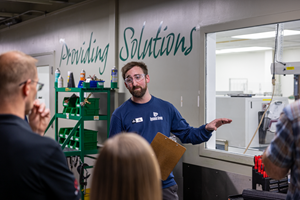SPE Auto Awards Innovations In Safety, Environmental, Process, Power Train
Check out these interesting 2014 SPE Automotive Innovation Awards' finalists in the safety, environmental, process/assembly, power train areas.
Having had the honor to be one of the Blue Ribbon judges of the 2014 SPE Automotive Innovation Awards, I thoroughly enjoyed the process of up-close presentations of such a broad variety of innovations. In this month’s issue, I reported on the award winners of each of the eight categories. Since I saw that nearly all other finalists’ innovations were newsworthy, I followed up with a series of blogs covering the categories of interior, exterior, materials, and chassis/hardware. Take a look at these four attention-grabbing innovations in the safety, environmental, process/assembly, and power train—all of which are transferable to other vehicles.
• Safety—Blind Spot Information System Tail Lamp: Featured in Ford’s F-150 pickup, this week’s announced winner of the 2015 North American Automotive Show for this vehicle category, this innovation is injection molded by Flex-N-Gate using Arkema’s V826, 1803/1808/18304 polymethyl methacrylate (PMMA). This, has been uniquely integrated into the rear blind-spot information system (BLIS) sensor rail-lamp assembly because the vehicle’s aluminum bumper does not permit normal installation behind the plastic fascia. The radar unit is housed behind two layers of plastic on a three-color, three-shot tail-lamp lens and features a cast-aluminum serviceable door, which also acts as a heat sink. In order to have the red opaque and clear material as one layer, the red opaque is the first shot in the molding process, followed by the clear over the red as the second shot which forms the backup window in the module area. By installing the BLIS system in the tail lamp, the lens cover also protects the module from direct impact, water, mud, or snow and the system saves $10 USD/vehicle. By having it designed this way, vs the initial design which was to have the module installed below the lamp, the following components were not needed: bracket, plastic cover, three fasteners; two gary ball attachments and unique D-Pillar.

• Environmental—Lightweight Material with Unique Synthetic & Bio-Fillers: This is featured on the 2015 Ford Mustang and injection molded by Tribar Manufacturing using the specialty TAP01 TPO from Amplas Compounding. The innovation entails the use of a unique synthetic mineral-based fiber plus a bio-filler (coconut powder) that replaces talc and PP plus rubber from recycle battery cases, and which provides a 5% density and 33% wall-thickness reduction in a rear decklid applique bracket and side-door cladding without sacrifice of properties. In addition, the material provides a 30% reduction in injection-molding cycle time and a 15% material cost reduction.

• Process/Assembly—High-Gloss Entertainment System Bezel: Featured in the 2013 Daimler Mercedes-Benz S-Class luxury sedan, this is produced by Johnson Controls and Trexel using Bayer MaterialScience T65 XF ABS/PC injection molded with Mucell foaming. This injection-molded frame for a DVD video bezel had to provide high dimensional stability, reduce warpage, lower weight and cost, and achieve a high-gloss Class A surface finish. Replacing an earlier two-part design featuring multi-layer painting, this single-piece part met all performance requirements thanks to the combination of two process technologies: microcellular foaming and tool heating/cooling. This led to a 40% weight savings and a 20% cost savings along with an additional 10% product cost savings while improving global quality perceptions due to excellent appearance and lower NVH--noise/vibration/harshness.

• Power Train—Charge Air Cooler Duct and Resonator: This is featured on the 2014 Fiat Chrysler Jeep Cherokee SUB and injection molded by Hutchinson FTS using Stanyl Diablo OCD2100 Nylon 4/6 from DSM Engineering Plastics. The DSM super-stabilized nylon 4/6 grade is used to mold a combination hot-side charge air cooler duct plus resonator in a unique shape that accommodates a difficult packaging environment. Doing so, eliminates one sub-component, delivering corrosion-free performance for longer life, and improved captive screw retention. Moreover, it enables improved seal design and retention, reduces weight by 32% and cost by 42% vs. its metal predecessor. It also allows the resonator to be incorporated as an insert for easier acoustic tuning and flexibility to use the same part in a similar package with different acoustic requirements.

Related Content
In Sustainable Packaging, the Word is ‘Monomaterial’
In both flexible and rigid packaging, the trend is to replace multimaterial laminates, coextrusions and “composites” with single-material structures, usually based on PE or PP. Nonpackaging applications are following suit.
Read MoreMedical Molder, Moldmaker Embraces Continuous Improvement
True to the adjective in its name, Dynamic Group has been characterized by constant change, activity and progress over its nearly five decades as a medical molder and moldmaker.
Read MoreFoam-Core Multilayer Blow Molding: How It’s Done
Learn here how to take advantage of new lightweighting and recycle utilization opportunities in consumer packaging, thanks to a collaboration of leaders in microcellular foaming and multilayer head design.
Read More‘Monomaterial’ Trend in Packaging and Beyond Will Only Thrive
In terms of sustainability measures, monomaterial structures are already making good headway and will evolve even further.
Read MoreRead Next
Lead the Conversation, Change the Conversation
Coverage of single-use plastics can be both misleading and demoralizing. Here are 10 tips for changing the perception of the plastics industry at your company and in your community.
Read MoreBeyond Prototypes: 8 Ways the Plastics Industry Is Using 3D Printing
Plastics processors are finding applications for 3D printing around the plant and across the supply chain. Here are 8 examples to look for at NPE2024.
Read MorePeople 4.0 – How to Get Buy-In from Your Staff for Industry 4.0 Systems
Implementing a production monitoring system as the foundation of a ‘smart factory’ is about integrating people with new technology as much as it is about integrating machines and computers. Here are tips from a company that has gone through the process.
Read More


























